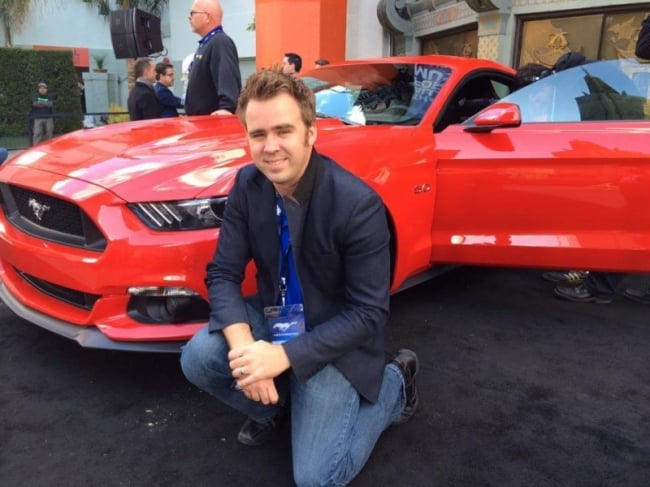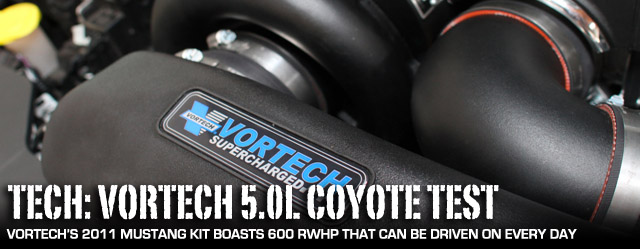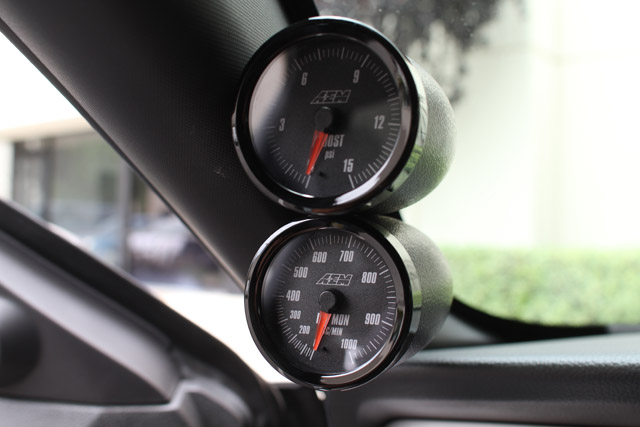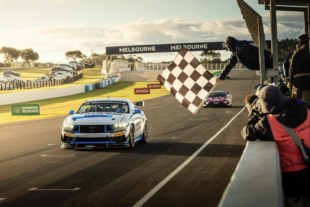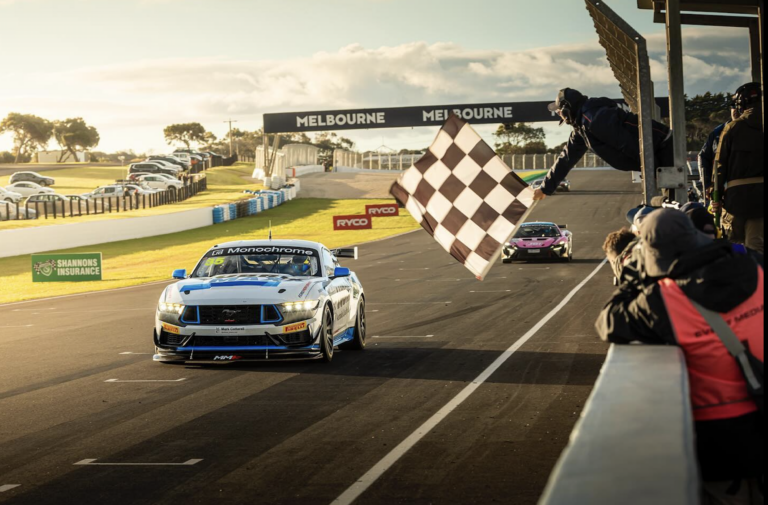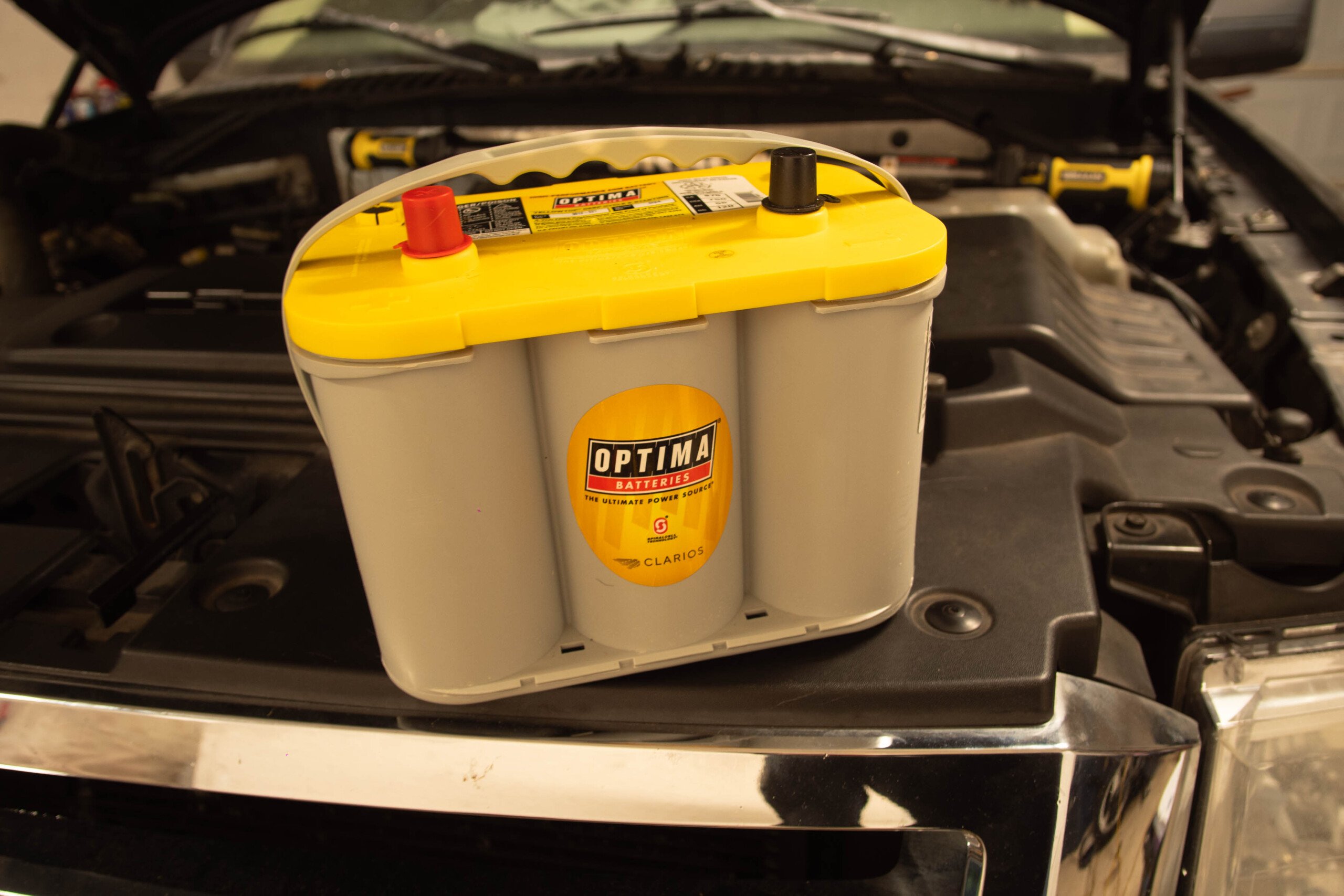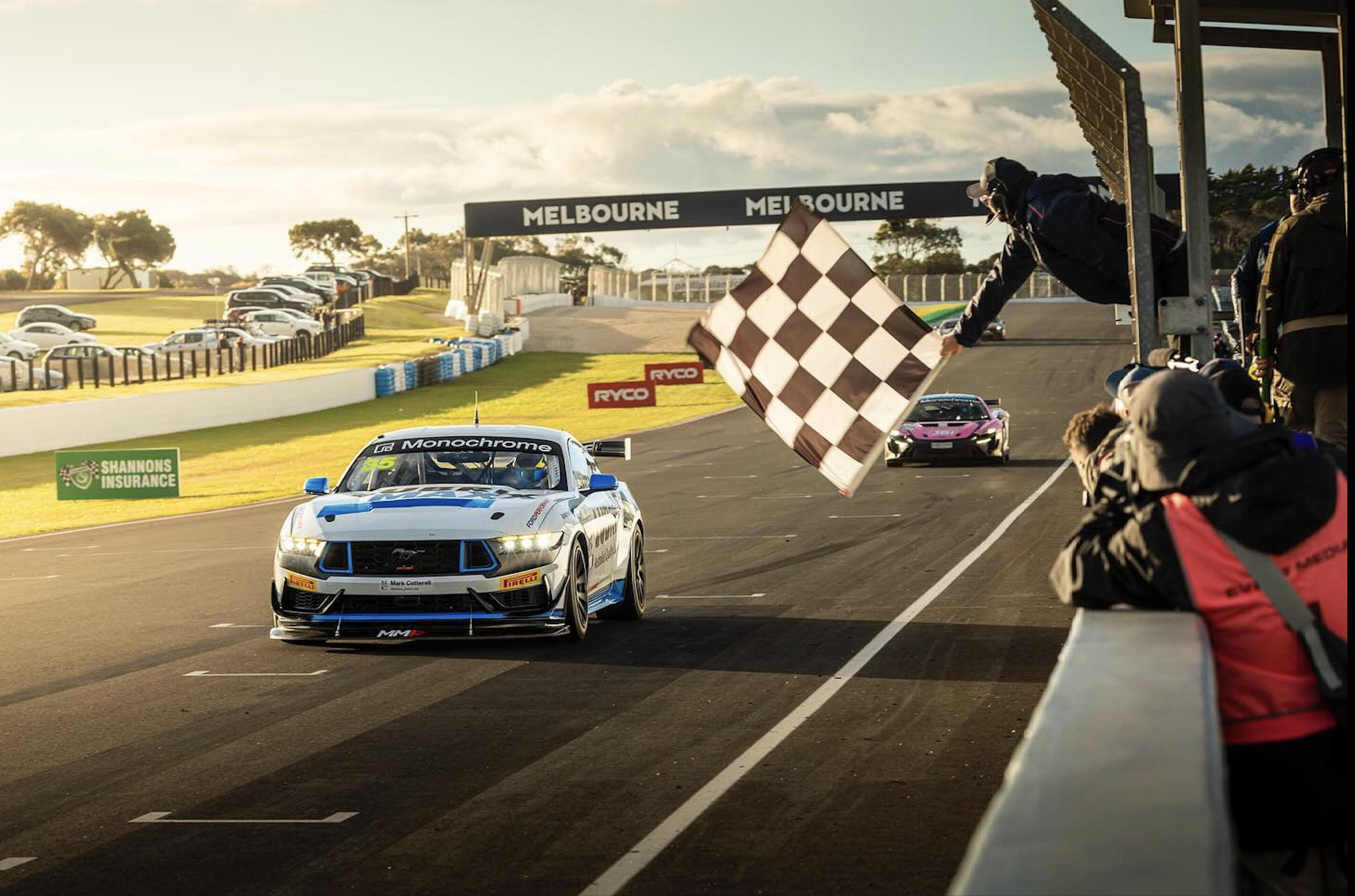If you are a Mustang enthusiast, surely by now you know the capabilities of the 2011 Mustang. While a few shops have been able to squeeze out 500 RWHP naturally aspirated, most go straight for the power adders, and that is exactly our goal with our 2011 Mustang project.
One of the goals of the “Wild E. Coyote” 2011 Mustang is a 10 second time slip. While we could have gone a variety of different ways – including nitrous or a turbo – we went with a company that has been producing superchargers for Mustangs for over twenty years, and that company is Vortech Superchargers.
In naturally aspirated form, our Mustang was making about 55 RWHP more than stock – thanks to a JPC header-back exhaust system, Airaid intake, and a custom SCT Flash tune by Brenspeed. For most, having a muscle car that lays down 428 RWHP to the pavement might be good enough, but it wasn’t for us.
Vortech’s 2011 Mustang System
Part of Vortech’s goal with the 2011 Mustang system was to design the only centrifugal supercharger kit for this car that will be CARB legal. There is a carbon trap inside the stock air box that will instantly void any manufacture’s ability to make a CARB legal kit that cannot transfer that feature over. “The primary reasons we placed the supercharger on the passenger side was packaging and CARB certification,” said Vortech’s Mike Reagan. “Based on the accessory placement and thermostat housing on the 5.0, it was a a cleaner installation on the passenger side too. Also, intercooler plumbing was a factor.”
Vortech offers the kit in three finishes – satin, polished or 20th anniversary black edition. Wanting the ultra clean appearance of an all-black kit, with went with the anniversary edition. The kit overall is the same, though the piping that leads to the throttle body, the supercharger, and intercooler are all powder coated black.
From there, Vortech stuck with their tried and true V3 self lubricated supercharger. Out of the box, the supercharger is designed to produce around 6.5 PSI with the stock air box and pulley combination. With a simple pulley change, the V3 is capable of supporting nearly 800 HP. “The V3 Si-Trim is an evolution of the S-trim, which is about 6% more efficient and supports 80 more horsepower,” said Reagan “The Si-Trim has a peak efficiency of 78% and it has a really broad map to accommodate about 95% of our street applications, plus it can support about 775 horsepower with smaller pulleys.”
The supercharger is hung to a bracket and pulley system that mounts to the passenger side cylinder head area utilizing the stock location bolts. Since the kit uses the stock serpentine belt configuration, a cog pulley setup is not possible with this kit. We have to mention that Justin Burcham of JPC Racing has made over 850 RWHP with the serpentine system. For those concerned about this, Reagan explains, “The way the bracket is laid out with the idlers and supercharger drive pulleys, it creates excellent belt wrap. The stability of the mounting bracket bracket further reduces any flexing under high horsepower applications.”

Vortech offers a tuner kit that does not come with a tuner or fuel injectors that can be puchased for around $4,900. The complete kit (above) comes with everything and runs about $5,400.
Helping keep that pressurized air cool is Vortech’s massive front mount intercooler. Due to the size of this intercooler, modifications to the inside of the front bumper cover will need to be made. “The charge cooler itself has the capability of supporting around 900 horsepower,” explained Reagan. “We basically tried to fit the largest heat exchanger we could without compromising engine cooling capacity.”
Installing the Vortech Supercharger Kit
If you are installing the kit yourself in a garage, you should plan for a full weekend to complete it. There is not much fabrication involved with this kit other than the trimming that will need to be done to the inside of the bumper cover and splash shield.

We first made quick work of removing the front bumper cover. Ford has done a great job of making this process easy and can be done in about 15 minutes. With the cover off, the bumper cushion and radiator side shrouds must be removed.
To help curve the radiator hose around the new bracket system, it must be modified with the parts supplied in the kit. First off, the radiator hose will be cut 2-inches from the quick release. Then place the included 90 degree pipe bend into the cut end of the radiator hose. The 90 degree bend that connects to the quick disconnect will be modified into a 45 degree angle and a 1.5-inch metal coupler will be inserted. Fit the modified hose on the engine before tightening down the worm gear clamps
From there we drained the coolant, removed the factory coolant tank, upper radiator hose and electric fan. Due to the supercharger placement, Vortech includes a new coolant tank that will mount to the passenger side shock tower.

The new coolant tank bolts directly between the passenger side valve cover and shock tower. There are a few steps that are noted in the instructions that will re-route your coolant tank lines so it can fit up to this new tank.
Nearing the end of the coolant system modifications is the electric fan. The bottom corners of the fan will need to be modified to allow for the intercooler pipe routing. The kit includes new finishing brackets for the corners of the fan plus an additional bracket that is used to move the fan module plug. A couple of additional modifications must be done to the top of the shroud to fit the intake pipe properly.
The bracket system comes pre-assembled from Vortech, though it is extremely important that all the proper stand offs are transferred onto the proper locations when installing the bracket system onto the engine. It might have been overkill, but we put a digital caliper on each spacer and wrote down the size onto the spacer, following the expanded bracket diagram on the Vortech’s instruction sheet. The kit does utilize a new serpentine belt and water pump pulley.
To allow for proper clearance to the supercharger assembly, the throttle body must be inverted so the drive motor will end up on the driver’s side. A new spacer is included with the kit and the throttle body function is unaltered in this new configuration. Vortech is currently working on a new spacer and intake pipe revision that will also work for BOSS intake manifolds.
The intercooler bolts between the bumper brace and radiator support with the included spacers. You will want to install the blow off valve onto the flanged intercooler pipe before installing that pipe into the car. Vortech includes a filter for the blow off valve that will quiet the sound of the rushing air, though we opted to leave it off. It is important that the MAF sensor is placed at 5 o’clock position (when looking at it from the driver’s side) and the air straightener is placed below the MAF housing. The straightener helps reduce turbulence through the MAF housing and makes the vehicle perform better. 'What we have discovered that on the newer Mustangs with the frequency-based mass air flow sensors, once the air saturates the meter, it goes off a speed density map that is coupled with the factory O2 sensor for determining the proper air/fuel ratios', explained Reagan. 'That way the MAF housing size should never be a limiting factor.
The V3 SI-Trim self-lubricated supercharger will then bolt directly to the supercharger bracket. Attached to the supercharger is a vent plug that must be installed. At the same time, check the internal fluid level of the supercharger to make sure it is adequately filled. There is a stainless drain line that will need to be placed in front of the bracket and secured. We used a zip tie to hold it to the radiator hose.

The kit includes factory GT500 52 lb/hr injectors, which are a bit taller than the factory injectors. “It is an OEM injector so you get all the advantages of a clean running injector that is designed by Ford, plus the emissions advantage is a plus too”, said Reagan. Vortech includes new fuel rail spacers to account for this.

A new molded intake pipe adapts the supercharger to the factory air box and includes a higher flowing K&N panel filter. Also included is a MAF plug that must be installed on the factory air box. Vortech supplies a small slip colar to adapt the smaller diameter stock air box to the new air intake pipe.

The inside of the front fascia will require trimming. Take your time and fit the bumper between cuts. Additionally, the lower splash shield will need to be modified for the intercooler piping. Don’t worry though; we have not encountered any issues with the intercooler piping hitting the ground while driving.

With everything double checked in the engine bay, we moved to the final step – installing the tune. Vortech includes an SCT tuner loaded with a specifically designed calibration for the kit. The canned Vortech tune is extremely safe with conservative air/fuel ratios and ignition mapping.
To keep a close eye on the amount of boost we were making, we turned to AEM Electronics for their 0-15 PSI boost gauge. It uses an electronic boost sensor and not a long vacuum line plumbed into the car, plus it features adjustable black lighting colors as well as gauge faces. The water/methanol gauge is for a up coming article where we install an AEM water/methanol injection kit.
Holding the gauges in place is a Speed of Sound gauge pod. Keeping you from having to cut up your stock pillar plastics, Speed of Sound includes a new OEM Mustang pillar plastic that comes pre-fitted with their custom, textured gauge holders that are designed for 2-1/16th” gauges. Speed of Sound offers these pods in all OEM color combinations.
Dyno and Driving Impressions
Key in the ignition, turn, and fire – the Mustang fired up immediately and idled with ease. The sound of the Vortech supercharger whine was music to our ears. Since we installed the Vortech kit on the Dynojet’s four post lift, we simply raised it and strapped it down on the rollers.

With the V3 Si-Trim pumping out 6.5 pounds of boost, we netted a total power figure of 536 RWHP and 446 lb/ft. As we mentioned before, the Vortech tune is extremely conservative and the air/fuel ratios averaged in the 10.5:1 range.

Vortech offers a competition air inlet assembly that is less restrictive than the factory air box. The assembly easily connects with one bolt and a new adaptor coupler. Additionally, it still utilizes the factory cold air ducting
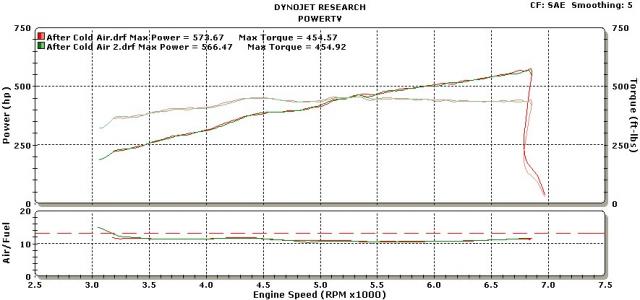
The competition air inlet adds about one more pound of boost due to the free flowing design. Air/fuel ratios were marginally leaner and the overall increase boosted us to 570 RWHP and 455 lb/ft – a 34 HP and 9 lb/ft improvement over the stock air box.
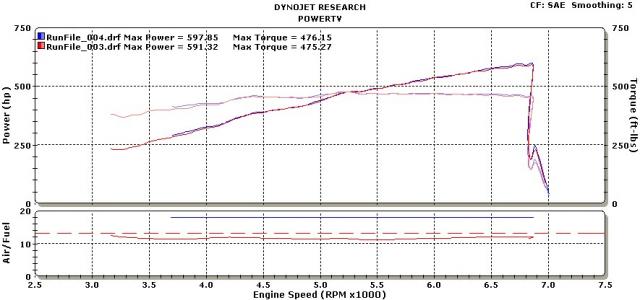
We knew that we could squeeze more power out of the Vortech tune while still remaining totally safe for our daily driving duties. We turned to veteran Mustang tuner Brent White of Brenspeed to help us coax a few more ponies out of this kit. With the stock intake installed again, we made 571 RWHP and 475 lb/ft. Then with the competition air inlet installed we were just shy of the 600 RWHP mark with 597 RWHP and 475 lb/ft. This was a booming increase of of 172 RWHP and 75 lb/ft versus our naturally aspirated runs and 204 RWHP and 106 lb/ft more than completely stock!

Making this much power, we are really beginning to push the limits of the stock fuel pump. To help keep things safe, Vortech has developed a pump voltage booster that is super easy to install. A supply power line must be connected directly to the battery and then there is the obvious ground. The violet with blue/green tracer wire going to the fuel pump relay will be the only wire that needs to be cut. The side coming in from the vehicle will route to the 14 gauge red wire on the booster, with the 12 gauge orange wire going to the relay side of the cut wire.
Driving the Mustang with its new-found Vortech power is extremely easy. The vehicle performs like it is naturally aspirated when driving under low throttle situations, but it is eager to pounce when the throttle hits the floor. This is where the Mustang feels like a different animal, making second gear nearly useless on street tires. The power delivery is super-linear and peak boost will be seen around 5500 RPM.
Taking it down the ol’ 1320
We were like kids waiting for Christmas until the next open track session was available at Auto Club Speedway in Fontana. This is the closest quarter mile track to our office and is only open about two weekends a month. This time we showed up for a PSCA Friday test session. We drove the Mustang to the track with our new 15×10 Weld wheels and Mickey Thompson 295/55/15 drag radials installed. With the tire pressure dropped to 14 PSI, we headed to the lanes.
The first real outing for the Mustang was at the NMRA/NMCA Fontana race where we entered the True Street category. It was 103 degrees out all weekend with a corrected density altitude of about 5,200 feet. With a freshly prepped track in the morning, we weren't launching the Mustang at a high enough RPM and it would bog slightly when clutching out. Later in the afternoon, launching at the same RPM, we had problems with wheel spin. So despite the heat and less than ideal 60-foot times, we still managed consistent 11.50 passes. On a cooler day with a better hooking track, 10-second passes shouldn't be a problem. Click on the pictures above for a larger version.
At the end of the day we couldn’t be happier with how our 2011 Mustang performed. Vortech includes everything you need with the kit and the installation takes about 10 hours without any specialty tools needed. If you are worried about driveability with a supercharger installed, don’t. With 700 HP at the crank, the Mustang drives exactly like stock around town and gives you all the power you need… when you need it. Best of all, our 10 second ET goal will soon be accomplished; now we just need to increase our handling efforts for our 1G skid pad run!


